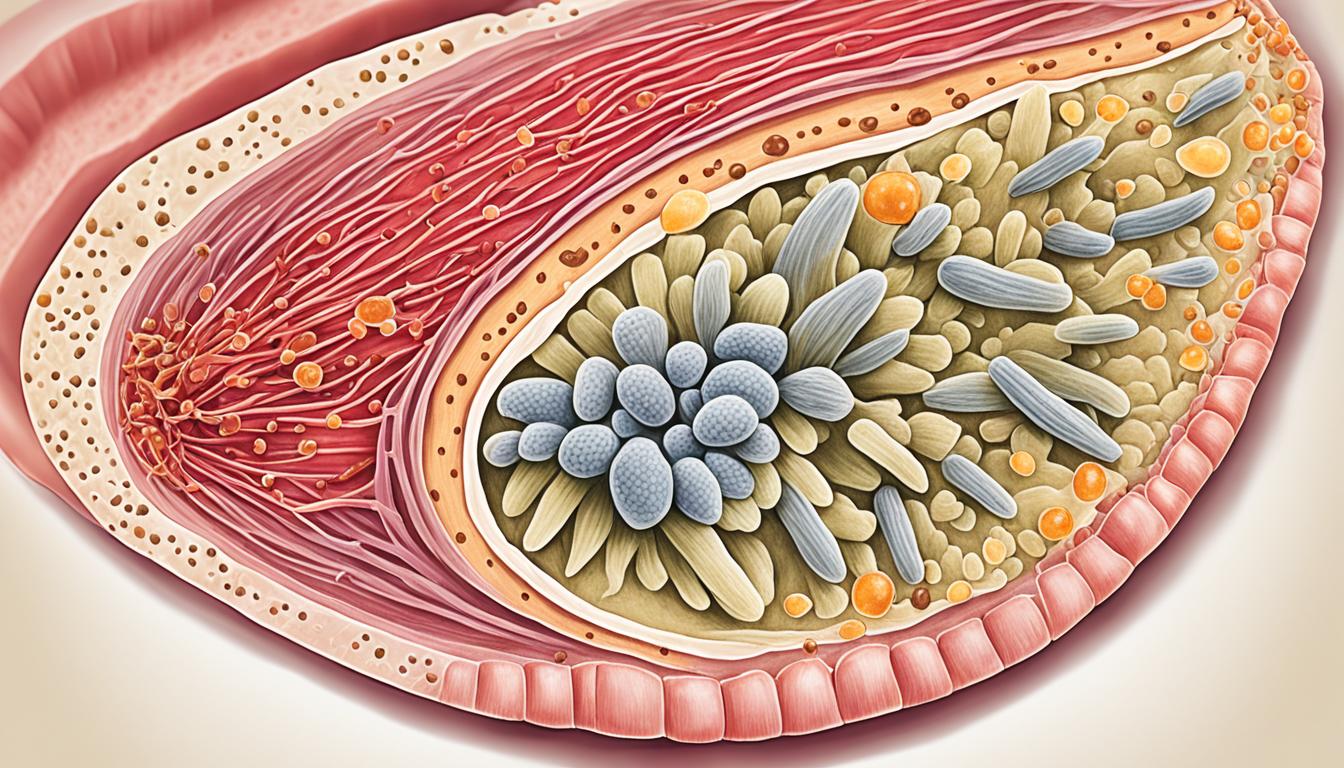Plantar warts come from the human papillomavirus (HPV). They show up on the bottom of your feet. Walking or standing on them can hurt. You can get them from touching someone’s skin or a surface where the virus is, like floors around pools or in locker rooms.
This problem is more common in kids and teens but can happen to anyone. The types of HPV that cause plantar warts are HPV-1, -2, -4, -60, and -63. A healthcare provider can usually tell if you have plantar warts by looking at them. Sometimes a skin biopsy is needed to be sure.
There are a few ways to treat plantar warts. You can buy creams with salicylic acid, try freezing them off with liquid nitrogen, use lasers, or have them cut out. Some doctors are also looking into using stem cell therapy as a treatment.
Key Takeaways:
- Warts plantar, or plantar warts, are a common skin disease caused by the human papillomavirus (HPV).
- They appear on the soles of the feet and can be painful when walking or standing.
- Plantar warts are transmitted through direct skin-to-skin contact or contact with contaminated surfaces.
- Diagnosis of plantar warts is usually done through a physical examination and may require further testing.
- Treatment options include salicylic acid creams, cryotherapy, laser therapy, surgical removal, and stem cell therapy as a potential treatment option.
Symptoms of Plantar Warts
Plantar warts come with symptoms that can really get in the way of your day-to-day. It’s key to know these signs for quick diagnosis and treatment. Here’s what to look out for with plantar warts:
Pain When Walking or Standing
Feeling pain or discomfort while moving or standing is a key sign of plantar warts. It is especially obvious if they are under parts where you put a lot of weight, like your toes or heels. The pressure on these warts can lead to pain, making it hard to carry out your daily activities.
Yellow Warts with a Crust
You might notice plantar warts as yellow, rough growths on the bottom of your feet. Over time, these warts might even form a crust because of dead skin collecting on them. Keep in mind, the look and feel of warts can be a bit different from person to person.
Black Spots on Warts
Sometimes, plantar warts show black spots in the middle. These spots happen because of the small blood vessels in the warts. Having black spots doesn’t mean it’s something serious, it’s just common with plantar warts.
Deep-Rooted Warts
Plantar warts can grow deep into your skin, which makes them hard to deal with. Their deep roots can also be painful. You might need stronger treatments to completely get rid of them.
If you notice any of these symptoms, talking to a doctor is important. Getting diagnosed and treated quickly can reduce your pain and stop any further issues.
| Common Symptoms | Severity |
|---|---|
| Pain when walking or standing | Moderate to severe |
| Yellow warts with a crust | Mild to moderate |
| Black spots on warts | Mild |
| Deep-rooted warts | Severe |
Causes and Transmission of Plantar Warts
The human papillomavirus (HPV) is the top cause of plantar warts. You can get it by touching an infected person or things they touched. These could be floors, towels, or even shoes. Importantly, the virus can stay alive on surfaces for a long time.
If the virus breaks into your skin, it infects the skin’s deeper cells. It then grows and causes plantar warts to form on your feet’s soles. Walking or standing on them can be very painful.
Plantar warts spread in different ways.
- Direct skin-to-skin contact: The main way to get plantar warts is by touching someone infected. This happens a lot when you walk barefoot in public, share items, or have close contact.
- Indirect contact through fomites: You can also get them from touching contaminated surfaces. For example, floors in locker rooms, towels, and shoes.
| Increased Risk Factors for Plantar Warts | Amount |
|---|---|
| Increased exposure to HPV | Moderate to high |
| Increased risk of skin barrier penetration (e.g., walking barefoot in communal areas) | High |
| Inappropriate immune responses to the virus | Low to moderate |
| Age, sex, and race | Varying degrees |
| Participation in activities associated with increased exposure to the virus (e.g., sports) | Moderate to high |
| Environment (e.g., close contact with affected individuals) | High |
| Socioeconomic status | Moderate |
Things like your age, gender, the things you do, where you live, and how much money you have can make you more likely to get plantar warts. Knowing these risk factors helps you avoid getting the virus.
Stem Cell Therapy for Plantar Warts
Stem cell therapy is a new and exciting way to treat plantar warts. It uses the power of stem cells to heal and build new tissue. Stem cells can transform into different cell types, including skin cells. They help our immune system fight the virus that causes plantar warts.
In early research, stem cell therapy for plantar warts has shown good results. It works better than the usual treatments. The new method clears warts more effectively and lowers their return. Although still being studied, if found safe and effective, stem cell therapy could change how we treat this skin issue.
Stem cell therapy targets the problem directly and may stop warts from coming back. Research is ongoing to confirm the benefits of this approach. The goal is to make patient recovery better and their lives healthier.

